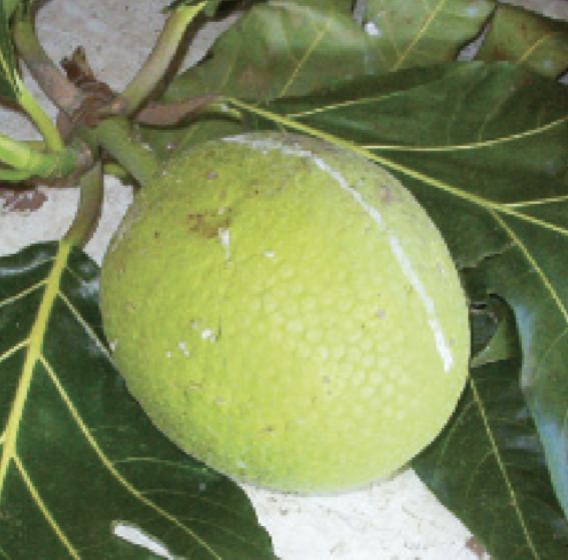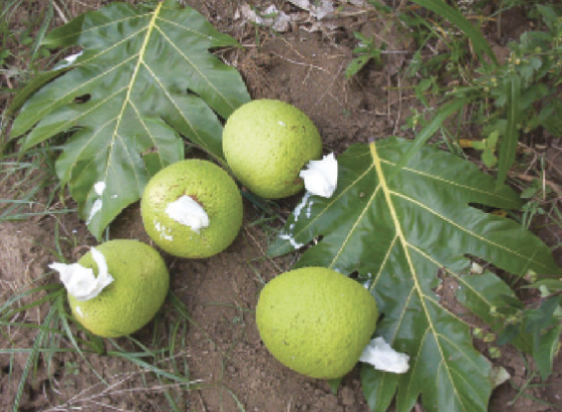Management
Breadfruit can produce a lot of sap – is that a problem?
Sap management must also be taken into consideration. Every part of the breadfruit tree, including the fruit, contains a white, sticky sap (also called latex). Sap is concentrated in the skin and around the core of the fruit. The sap that is mainly seen as small globules on various parts of the skin, and which is considered an indicator of fruit maturity, poses little problem (Fig. 12a). Sap may ooze in copious amounts from the stem after the fruit has been picked or from abrasions on the skin causing unsightly discoloration of the fruit which is considered a marketing problem (Fig. 12b). Nature’s Way Cooperative Manual describes a relatively simple method for managing the effect of sap on harvested breadfruit.


Figure 12a: Sap as an indicator of maturity; 12b: Unsightly sap oozing from the stem


Figure 12c: Tissue-type paper wrapped around end of fruit stem; 12d: Fruit in crate with paper wad retained.
When the fruit is harvested it is held stem-down to prevent sap from dripping down the stem onto the surface of the fruit. A wad of tissue-type paper is wrapped around the end of the fruit stem to absorb oozed sap (Fig. 12c). Fruit is placed directly into the plastic crate with the paper wad retained or on the ground until sap flow ceases, generally after 10-15 minutes (Fig. 12d).
Good postharvest practices are essential so that the fruit arrives at its destination with minimal quality degradation. Postharvest refers to all practices involved in transport and preparing or storing the fruit for sale, cooking or processing. High quality, unblemished fruit will fetch the best prices. If breadfruit is stored in suboptimal conditions, it will ripen, ruining the fruit for the firm-mature market. Minimizing bruising or other injury must be the overriding aim of any process for handling of fresh or frozen fruit.
How can I store breadfruit?
Ideally fruit is harvested, sorted, cleaned, packaged and delivered shortly afterwards to the customer. If this is not possible, then proper storage conditions are essential so that fruit quality, and therefore price, is maintained.
As green mature fruit will usually ripen and soften within 1-3 days, room temperature storage is the least preferred method. Freshly harvested fruit that is fully submerged in cool, clean fresh water can maintain quality for several days or longer (Fig. 13). Refrigeration can also increase shelf life with the optimum temperature range being 12-16°C. At these temperatures, a shelf life of 10 days is possible and can be extended to 14 days if the fruit is wrapped in plastic. Below 12°C the skin will turn brown.

Figure 13: Breadfruit held in cool water bath to extend shelf life (Mahen’s Exports, Sigatoka Valley Fiji)
Keeping the water temperature at about 13°C removes field heat and slows internal respiration. Warm water tends to cause swelling and splitting of fruit and therefore should be avoided. Fruit that is in an advanced state of maturity may take on water through fissures in the skin and develop severe cracks.
